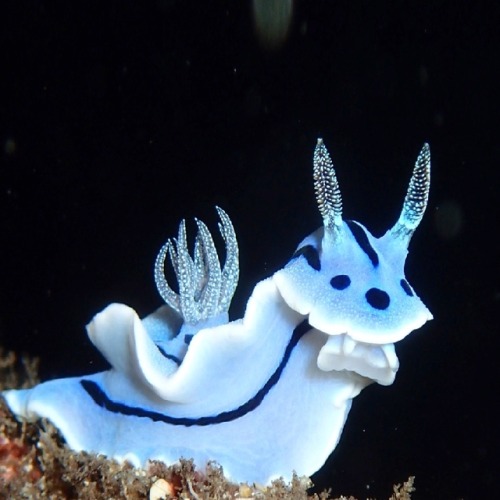Blue Sea Snail (Chromodoris Willanii), A Shell-less Marine Gastropod Mollusk.It Is Most Common In The


Blue sea snail (Chromodoris willanii), a shell-less marine gastropod mollusk.It is most common in the seas of various islands of Indonesia. You can also find them near the shores of Philippines. Chromodoris Wilani is a sponge eater. They feed on Semitaspongia groups of sponges.
More Posts from N0t-a-gh0st and Others

hot take: trans women can look however they want!
ok guys help
if an older man keeps buying you and your mom things, and keeps taking you on vacation without you really wanting to is he being both of our sugar daddy? or just one and trying to play it cool? hypothetically, of course.
asking for a friend.
a hypothetical friend.

before every 8am class
reblog if you’re def the kind of person who
says “cool beans”
does finger guns
says “coolio”
“my guy”
“my dude”
ironically said “get rekt scrub” and now can’t stop
“ayyeee”
makes a lot of weird faces
my teacher
constantly swears in classic lit novel titles and idk whether to be offended by this onslaught of culture or impressed he actually remembers them

“Welcome to being dead.”
—that dog in All Dogs Go To Heaven
Watch Mercury Transit the Sun on Nov. 11
On Nov. 11, Earthlings will be treated to a rare cosmic event — a Mercury transit.

For about five and a half hours on Monday, Nov. 11 — from about 7:35 a.m. EST to 1:04 p.m. EST — Mercury will be visible from Earth as a tiny black dot crawling across the face of the Sun. This is a transit and it happens when Mercury lines up just right between the Sun and Earth.
Mercury transits happen about 13 times a century. Though it takes Mercury only about 88 days to zip around the Sun, its orbit is tilted, so it’s relatively rare for the Sun, Mercury and Earth to line up perfectly. The next Mercury transit isn’t until 2032 — and in the U.S., the next opportunity to catch a Mercury transit is in 2049!
How to watch
Our Solar Dynamics Observatory satellite, or SDO, will provide near-real time views of the transit. SDO keeps a constant eye on the Sun from its position in orbit around Earth to monitor and study the Sun’s changes, putting it in the front row for many eclipses and transits.
Visit mercurytransit.gsfc.nasa.gov to tune in!

Our Solar Dynamics Observatory also saw Mercury transit the Sun in 2016.
If you’re thinking of watching the transit from the ground, keep in mind that it is never safe to look directly at the Sun. Even with solar viewing glasses, Mercury is too small to be easily seen with the unaided eye. Your local astronomy club may have an opportunity to see the transit using specialized, properly-filtered solar telescopes — but remember that you cannot use a regular telescope or binoculars in conjunction with solar viewing glasses.
Transits in other star systems
Transiting planets outside our solar system are a key part of how we look for exoplanets.
Our Transiting Exoplanet Survey Satellite, or TESS, is NASA’s latest planet-hunter, observing the sky for new worlds in our cosmic neighborhood. TESS searches for these exoplanets, planets orbiting other stars, by using its four cameras to scan nearly the whole sky one section at a time. It monitors the brightness of stars for periodic dips caused by planets transiting those stars.

This is similar to Mercury’s transit across the Sun, but light-years away in other solar systems! So far, TESS has discovered 29 confirmed exoplanets using transits — with over 1,000 more candidates being studied by scientists!

Discover more transit and eclipse science at nasa.gov/transit, and tune in on Monday, Nov. 11, at mercurytransit.gsfc.nasa.gov.
Make sure to follow us on Tumblr for your regular dose of space: http://nasa.tumblr.com.
Ya MCM said ew when you told him you were on your period. He’s 27.
-
 kyoshirosenryo reblogged this · 1 month ago
kyoshirosenryo reblogged this · 1 month ago -
 anxiousinternetfox liked this · 2 months ago
anxiousinternetfox liked this · 2 months ago -
 what-if-a-black-dog liked this · 2 months ago
what-if-a-black-dog liked this · 2 months ago -
 illyriashade56 liked this · 2 months ago
illyriashade56 liked this · 2 months ago -
 jim-activated19940216 liked this · 2 months ago
jim-activated19940216 liked this · 2 months ago -
 everythingisliminal reblogged this · 2 months ago
everythingisliminal reblogged this · 2 months ago -
 achitachi liked this · 3 months ago
achitachi liked this · 3 months ago -
 spooks-and-sunshine liked this · 3 months ago
spooks-and-sunshine liked this · 3 months ago -
 min-izz-le reblogged this · 5 months ago
min-izz-le reblogged this · 5 months ago -
 inf00mars reblogged this · 6 months ago
inf00mars reblogged this · 6 months ago -
 bugbeds liked this · 6 months ago
bugbeds liked this · 6 months ago -
 sztefa001 reblogged this · 7 months ago
sztefa001 reblogged this · 7 months ago -
 perytonpred reblogged this · 7 months ago
perytonpred reblogged this · 7 months ago -
 perytonpred liked this · 7 months ago
perytonpred liked this · 7 months ago -
 vividvexation liked this · 9 months ago
vividvexation liked this · 9 months ago -
 girlsontanks reblogged this · 9 months ago
girlsontanks reblogged this · 9 months ago -
 pieandsnails liked this · 11 months ago
pieandsnails liked this · 11 months ago -
 parapappapa liked this · 1 year ago
parapappapa liked this · 1 year ago -
 transgriffin liked this · 1 year ago
transgriffin liked this · 1 year ago -
 eggy-the-egg liked this · 1 year ago
eggy-the-egg liked this · 1 year ago -
 thefatcat-13 liked this · 1 year ago
thefatcat-13 liked this · 1 year ago -
 3yant3ban liked this · 1 year ago
3yant3ban liked this · 1 year ago -
 redactedarcher reblogged this · 1 year ago
redactedarcher reblogged this · 1 year ago -
 vincent-honey reblogged this · 1 year ago
vincent-honey reblogged this · 1 year ago -
 robotwrangler liked this · 1 year ago
robotwrangler liked this · 1 year ago -
 nautilusse reblogged this · 1 year ago
nautilusse reblogged this · 1 year ago -
 pandacatxd reblogged this · 1 year ago
pandacatxd reblogged this · 1 year ago -
 smoke- liked this · 1 year ago
smoke- liked this · 1 year ago -
 eaglewhensheflies reblogged this · 1 year ago
eaglewhensheflies reblogged this · 1 year ago -
 eaglewhensheflies liked this · 1 year ago
eaglewhensheflies liked this · 1 year ago -
 pandacatxd liked this · 1 year ago
pandacatxd liked this · 1 year ago -
 unbeknownstunknown liked this · 1 year ago
unbeknownstunknown liked this · 1 year ago -
 slugchild liked this · 1 year ago
slugchild liked this · 1 year ago -
 greyscale-hands liked this · 1 year ago
greyscale-hands liked this · 1 year ago -
 culurgionitas liked this · 2 years ago
culurgionitas liked this · 2 years ago -
 reideamarillo reblogged this · 2 years ago
reideamarillo reblogged this · 2 years ago -
 shizukais liked this · 2 years ago
shizukais liked this · 2 years ago -
 i-hate-loid-garmadon liked this · 2 years ago
i-hate-loid-garmadon liked this · 2 years ago -
 livingd34ddoll liked this · 2 years ago
livingd34ddoll liked this · 2 years ago -
 depressed-n-stoned liked this · 2 years ago
depressed-n-stoned liked this · 2 years ago -
 b1tten-k1tten liked this · 2 years ago
b1tten-k1tten liked this · 2 years ago -
 faded-doll-hi liked this · 2 years ago
faded-doll-hi liked this · 2 years ago -
 gardencemetery reblogged this · 2 years ago
gardencemetery reblogged this · 2 years ago -
 gardencemetery liked this · 2 years ago
gardencemetery liked this · 2 years ago -
 everseem reblogged this · 2 years ago
everseem reblogged this · 2 years ago -
 faceoil liked this · 2 years ago
faceoil liked this · 2 years ago
